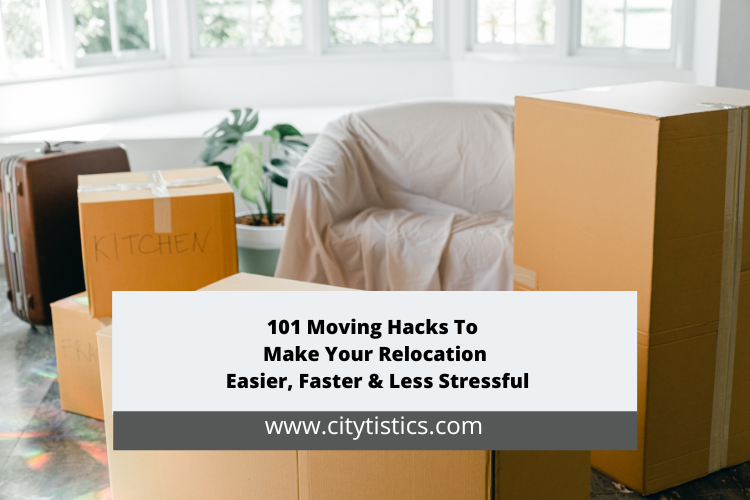Relocating to a new home, whether across town or in an entirely different city, can be an exciting yet daunting experience. The thought of packing up your entire life and starting fresh in a new place often brings a mix of anticipation and stress. However, fear not! We’re here to help make your upcoming move a breeze with our comprehensive guide to 101 moving hacks.
What if you could streamline the entire process, making it easier, faster, and, more importantly, less stressful?
Well, you’re in the right place.
In this article, we’ve gathered an extensive collection of moving hacks that cover every aspect of the moving process, from the early planning stages to settling into your new home. We’ll guide you through packing strategies that maximize space and minimize breakages, offer tips for efficient organization, share secrets for finding reliable movers, and much more.
Stay Organized

- Start the packing process well in advance to avoid any last-minute rush.
- Create a packing timeline: Make a schedule or timeline to organize your packing tasks.
- Declutter before packing: Sort through your belongings and remove anything you no longer need or use.
- Label boxes clearly: Clearly mark each box with its contents and the room it belongs to for easy unpacking.
- Pack room by room: Focus on one room at a time to stay organized and reduce confusion during unpacking.
- Keep hardware organized: Place screws, bolts, and other small hardware in labeled bags and tape them to the corresponding furniture or equipment.
- Pack a bag for each family member: Give each family member a bag or backpack to pack their personal belongings for the move.
- Organize the family: Speaking of family, ensure everyone is on the same page and has been given their own responsibilities.
- Pack important documents separately: Keep important documents, such as passports, birth certificates, and medical records, in a safe and easily accessible place.
- Pack an inventory list: Make an inventory list of each box and its contents to easily track your belongings during the move.
- Stay organized: Throughout the packing process, keep track of boxes, labels, and belongings to ensure a smooth transition to your new home.
- Take measurements of furniture and doorways: Ensure your furniture will fit through doorways and into your new home by measuring before the move.
- Pack similar items together: Group similar items together to make unpacking and organizing easier.
- Disassemble furniture when necessary: Take apart large furniture pieces that won’t fit through doorways or into the moving truck.
- Research: Find and contact movers and storage units well in advance to prevent issues on a moving day.
Pack Smarter, Not Harder

- Gather packing supplies in advance: Collect sturdy boxes, packing tape, bubble wrap, packing paper, markers, and labels well in advance to avoid being caught short.
- Use small boxes for heavy items: Pack heavier items in smaller boxes to prevent them from becoming too heavy to lift.
- Pack books in small boxes: Books can become heavy quickly, so use smaller boxes to make them easier to lift.
- Use clothing for padding: Wrap fragile items with soft clothing items like shirts or socks to save on packing materials.
- Use suitcases for heavy items: Utilize your suitcases to pack heavy items like books or shoes.
- Pack electronic equipment in their original boxes: If available, use the original boxes and packaging materials for electronics like computers, TVs, and audio systems.
- Pack kitchen appliances with care: Wrap small kitchen appliances in bubble wrap or packing paper and pack them in sturdy boxes.
- Use Ziploc bags for small parts: Place small parts, screws, or accessories in Ziploc bags and label them accordingly.
- Pack a separate box for remote controls: Keep all remote controls together in one box to avoid misplacing them during the move.
- Pack clothing on hangers: Keep clothing on hangers and place them in large garbage bags, tying the bags around the hangers to keep them together.
- Use vacuum-sealed bags for bulky clothing: Reduce the space clothing takes up by using vacuum-sealed bags for items like blankets, pillows, and winter coats.
- Take advantage of vertical space: When packing boxes, stack items vertically to maximize space and prevent items from shifting during transit.
- Enlist help: Seek assistance from friends, family, or professional movers to help with packing, loading, and unloading.
- Take photos of furniture and room layouts: Before moving furniture into your new home, take photos of the layout and measurements of each room. This will help you plan where each piece of furniture should go, making the unpacking and arrangement process more efficient.
- Label clearly: You don’t want to be unpacking and having to decipher bad handwriting!
Safety: Avoid Spills, Smashes, and Loss

- Wrap fragile items carefully: Use bubble wrap, packing paper, or towels to protect delicate items during transit.
- Label boxes “Fragile” when needed: Clearly mark boxes containing fragile items to ensure careful handling during the move.
- Reinforce boxes with extra tape: Add extra layers of packing tape to the bottom and sides of boxes to ensure they stay secure.
- Pack plates vertically: Stack plates vertically with padding between each plate to reduce the risk of breakage.
- Protect mirrors and artwork: Tape an “X” across the glass of mirrors and artwork to help prevent shattering.
- Use towels and linens for padding: Utilize towels, linens, or blankets to provide additional cushioning for fragile items.
- Fill empty spaces in boxes: Use packing paper, towels, or clothing to fill gaps in boxes and prevent items from shifting during transit.
- Seal toiletries and liquids in plastic bags: Prevent spills by sealing toiletries and liquids in plastic bags before packing them.
- Pack a separate box for important valuables: Keep jewelry, valuable documents, and other precious items in a separate box that you personally transport.
- Pack fireproof documents securely: If you have important documents that are fireproof, ensure they are packed securely to protect them during the move.
- Pack a cooler for perishable food: If you’re moving a short distance, use a cooler to transport perishable food items.
- Pack gardening plants with care: If you’re moving plants, secure them properly in appropriate containers and provide adequate ventilation.
- Take breaks and celebrate progress: Moving and unpacking can be physically and mentally demanding, so remember to take breaks and rest.
- Lift with proper technique: Bend your knees, lift with your legs, and avoid lifting heavy items with your back. Use teamwork or moving equipment like dollies and straps to assist with heavy lifting.
- Be mindful of weight limits: Adhere to weight limits and guidelines provided by your moving equipment or truck rental company.
- If moving in adverse weather conditions, take necessary precautions such as wearing appropriate clothing, using tarps or plastic covers, and ensuring good traction on slippery surfaces.
Think Ahead of the Move

- Pack a “Last in, First out” box: Prepare a box with items you will need immediately upon arrival in your new home, such as kitchen essentials, bedding, and bathroom supplies.
- Take a photo of electronic setups: Before disassembling any electronics, take pictures of the cables and connections for easy reassembly.
- Pack a “Survival Kit” for moving day: Prepare a bag with snacks, water, and essential items you may need during the move.
- Pack a separate box for cleaning supplies: Keep cleaning supplies separate for easy access when you arrive at your new home.
- Wrap cords and cables: Bundle cords and cables together using twist ties or zip ties to prevent tangling.
- Keep essential tools handy: Keep a small toolkit with essential tools nearby for any necessary furniture assembly or repairs.
- Use colored labels for each room: Assign a specific color label to each room to quickly identify which boxes belong where.
- Pack seasonal items separately: If you’re moving during a specific season, pack seasonal items separately to easily access them when needed.
- Pack a separate box for pet supplies: Keep pet essentials like food, medication, and toys in a separate box for easy access upon arrival.
- Pack items from the same room in the same box: Keep items from the same room together to streamline the unpacking process.
- Pack a separate box for bathroom essentials: Keep bathroom essentials like towels, toilet paper, and toiletries in a separate box for easy access.
- Unpack major furniture first: Begin by assembling and placing major furniture items such as beds, couches, and tables.
- Unpack one room at a time: Focus on unpacking one room completely before moving on to the next.
- Install closet organizers or hanging rods in closets early on. This will make it easier to hang and organize your clothing as you unpack.
- Dispose of packing materials as you go: As you unpack, break down and discard empty boxes or set them aside for recycling.
Dealing with Movers

- Communicate clearly with the movers: Clearly communicate your expectations and any special instructions to the movers before the moving day.
- Give Clarity: Draw up a floor plan or specific directions for where each item should be placed in your new home.
- Pack boxes tightly to maximize space and prevent them from shifting during transportation.
- Place heavier and sturdier items on the bottom and lighter items on top.
- Utilize the vertical space by stacking boxes and furniture strategically.
- Utilize furniture sliders, moving straps, dollies, and other moving equipment to safely and efficiently move heavy items without straining yourself or the movers.
- Before loading items into the removal van, take inventory and document any existing damage or scratches on furniture or valuable items.
- Moving can be physically demanding, so consider providing refreshments such as water, snacks, or even a light meal for the movers.
- Have a list of contact numbers ready in case there are any issues during the move.
- Keep important documents, such as passports, birth certificates, and financial records, as well as valuable items like jewelry and electronics, with you during the move.
- Before the movers arrive, clear the path to the removal van, ensuring there are no obstacles or hazards.
- Park the removal van as close to your home as possible to minimize the distance and effort required for loading and unloading.
- Check with your moving company to confirm their insurance coverage and liability policies.
- Understand the extent of their liability for any damages that may occur during the move and consider additional insurance coverage if necessary.
- Be present and available during the loading and unloading process to answer any questions the movers may have regarding specific items or placement.
Buying Packing Supplies

- Take inventory first: Before buying packing supplies, take inventory of your belongings to get an idea of how many boxes and other materials you’ll need.
- Start early: Begin purchasing packing supplies well in advance of your move to avoid last-minute rushes and potential shortages.
- Estimate quantities: Estimate the number of boxes you’ll need based on the size of your home and the amount of stuff you have. Remember to consider different box sizes for various items. Also, it’s better to have more than less, so don’t be frugal!
- Use online marketplaces: Check online marketplaces like Amazon, eBay, or Craigslist for discounted packing supplies. You may find barely used boxes or packing materials at a lower cost.
- Visit local stores: Check with local grocery stores, liquor stores, or bookstores for free or discounted boxes they may be willing to give away.
- Ask friends and neighbors: Ask friends, family, and neighbors if they have any spare boxes or packing supplies they can lend or sell to you at a lower cost.
- Look for bundle deals: Some stores or online sellers offer bundle deals on packing supplies, including boxes, tape, bubble wrap, and other essentials. Purchasing in bulk can often save you money:
- Consider eco-friendly options: Look for eco-friendly packing supplies, such as recyclable boxes or biodegradable packing peanuts, to minimize your environmental impact.
- Utilize alternative materials: Instead of purchasing bubble wrap, use towels, blankets, or clothing to wrap fragile items and provide cushioning.
- Optimize space in boxes: Maximize space in boxes by using packing techniques like rolling clothes or nesting smaller items inside larger ones. This will help you minimize the number of boxes needed.
- Check with your moving company: If you’re hiring professional movers, inquire if they provide packing supplies as part of their services or if they offer discounts on supplies.
- Repurpose household items: Use suitcases, laundry baskets, and storage bins you already have to pack and transport belongings, reducing the need for additional boxes.
- Get creative with padding: Instead of buying packing paper, use newspaper, tissue paper, or old magazines to wrap delicate items and provide cushioning.
- Borrow or rent moving equipment: Instead of buying moving equipment like dollies or furniture pads, consider borrowing or renting them for a fraction of the cost.
- Donate or sell packing supplies afterward: After your move, consider donating or selling your gently used packing supplies to recoup some of the costs and help others who are moving.
Final Thoughts
Congratulations! You’ve reached the end of our comprehensive guide to 101 moving hacks, designed to make your relocation easier, faster, and less stressful. We hope that the tips, tricks, and strategies shared in this article have provided you with valuable insights and practical solutions to tackle every aspect of your move.
For more inspiration on buying and selling a house, be sure to check out the rest of our site!

